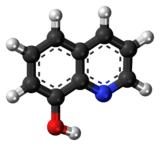8-Hydroxyquinoline
8-Hydroxyquinoline (aka oxine) is a chelating agent which has been used for the quantitative determination of metal ions.
 | |
 | |
| Names | |
|---|---|
| IUPAC name
Quinolin-8-ol, 8-Quinolinol | |
| Other names
1-azanaphthalene-8-ol, Fennosan H 30, hydroxybenzopyridine, hoxybenzopyridine, oxychinolin, oxyquinoline, phenopyridine, quinophenol, oxine | |
| Identifiers | |
3D model (JSmol) |
|
| ChEBI | |
| ChEMBL | |
| ChemSpider | |
| ECHA InfoCard | 100.005.193 |
| KEGG | |
PubChem CID |
|
| UNII | |
CompTox Dashboard (EPA) |
|
| |
| |
| Properties | |
| C9H7NO | |
| Molar mass | 145.16 g/mol |
| Appearance | White crystalline needles |
| Density | 1.034 g/cm3 |
| Melting point | 76 °C (169 °F; 349 K) |
| Boiling point | 276 °C (529 °F; 549 K) |
| Pharmacology | |
| G01AC30 (WHO) A01AB07 (WHO) D08AH03 (WHO) R02AA14 (WHO) | |
| Hazards | |
| Main hazards | flammable |
| Safety data sheet | External MSDS |
Except where otherwise noted, data are given for materials in their standard state (at 25 °C [77 °F], 100 kPa). | |
| Infobox references | |
In aqueous solution 8-hydroxyquinoline has a pKa value of ca. 9.9[2] It reacts with metal ions, losing the proton and forming 8-hydroxyquinolinato-chelate complexes.
The aluminium complex[3] is a common component of organic light-emitting diodes (OLEDs). Variations in the substituents on the quinoline rings affect its luminescence properties.[4]
In the photochemically induced excited-state zwitterionic isomers are formed in which the hydrogen atom is transferred from oxygen to nitrogen.[5]
The complexes as well as the heterocycle itself exhibit antiseptic, disinfectant, and pesticide properties,[6][7] functioning as a transcription inhibitor.[8] Its solution in alcohol is used in liquid bandages. It once was of interest as an anti-cancer drug.[9]
A thiol analogue, 8-mercaptoquinoline is also known.[10]
The roots of the invasive plant Centaurea diffusa release 8-hydroxyquinoline, which has a negative effect on plants that have not co-evolved with it.[11]
References
- Cölle, M.; Dinnebier, R. E.; Brütting, W. (2002). "The structure of the blue luminescent δ-phase of tris(8-hydroxyquinoline)aluminium(III) (Alq3)". Chemical Communications. 2002 (23): 2908–9. doi:10.1039/b209164j. PMID 12478807.
- Albert, A.; Phillips, J. N. (1956). "264. Ionization Constants of Heterocyclic Substances. Part II. Hydroxy-Derivatives of Nitrogenous Six-Membered Ring-Compounds". Journal of the Chemical Society (Resumed). 1956: 1294–1304. doi:10.1039/JR9560001294.
- Katakura, R.; Koide, Y. (2006). "Configuration-Specific Synthesis of the Facial and Meridional Isomers of Tris(8-hydroxyquinolinate)aluminum (Alq3)". Inorganic Chemistry. 45 (15): 5730–5732. doi:10.1021/ic060594s. PMID 16841973.
- Montes, V. A.; Pohl, R.; Shinar, J.; Anzenbacher, P. Jr. (2006). "Effective Manipulation of the Electronic Effects and Its Influence on the Emission of 5-Substituted Tris(8-quinolinolate) Aluminum(III) Complexes". Chemistry: A European Journal. 12 (17): 4523–4535. doi:10.1002/chem.200501403. PMID 16619313.
- Bardez, E.; Devol, I.; Larrey, B.; Valeur, B. (1997). "Excited-State Processes in 8-Hydroxyquinoline: Photoinduced Tautomerization and Solvation Effects". The Journal of Physical Chemistry B. 101 (39): 7786–7793. doi:10.1021/jp971293u.
- Phillips, J. P. (1956). "The Reactions of 8-Quinolinol". Chemical Reviews. 56 (2): 271–297. doi:10.1021/cr50008a003.
- "8-Hydroxyquinoline". Medical Dictionary Online. Archived from the original on 2016-10-09. Retrieved 2016-03-09.
- "8-Hydroxyquinoline". Sigma-Aldrich. Retrieved 2012-05-23.
- Shen, A. Y.; Wu, S. N.; Chiu, C. T. (1999). "Synthesis and Cytotoxicity Evaluation of some 8-Hydroxyquinoline Derivatives". Journal of Pharmacy and Pharmacology. 51 (5): 543–548. doi:10.1211/0022357991772826. PMID 10411213.
- Fleischer, Holger "Structural chemistry of complexes of (n - 1)d10nsm metal ions with β-N-donor substituted thiolate ligands (m=0, 2)" Coordination Chemistry Reviews 2005, volume 249, pp. 799-827. doi:10.1016/j.ccr.2004.08.024
- Vivanco, J.M.; Bais, H.P.; Stermitz, F.R.; Thelen, G.C.; Callaway, R.M. (2004). "Biogeographical variation in community response to root allelochemistry: novel weapons and exotic invasion". Ecology Letters. 7 (4): 285–292. doi:10.1111/j.1461-0248.2004.00576.x.
aluminium(III)-from-xtal-2000-CM-3D-ellipsoids.png)